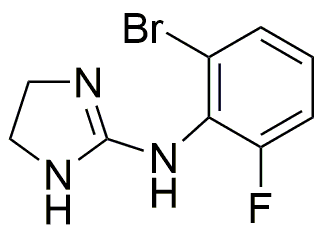Romifidine is widely utilized in research focused on:
- Veterinary Medicine: Primarily used as a sedative and analgesic in horses, providing effective sedation during procedures, which enhances animal welfare and safety.
- Pharmacological Studies: Serves as a valuable compound for studying the effects of sedation and analgesia, helping researchers develop better anesthetic protocols.
- Comparative Medicine: Its applications in equine medicine allow for insights that can be translated into human medicine, particularly in pain management and sedation techniques.
- Research on Drug Interactions: Used to explore interactions with other anesthetics, helping to optimize sedation protocols for various veterinary procedures.
- Behavioral Studies: Assists in understanding the behavioral effects of sedation in animals, which is crucial for improving handling and treatment in veterinary practices.
Informations générales
Propriétés
Sécurité et réglementation
Applications
Romifidine is widely utilized in research focused on:
- Veterinary Medicine: Primarily used as a sedative and analgesic in horses, providing effective sedation during procedures, which enhances animal welfare and safety.
- Pharmacological Studies: Serves as a valuable compound for studying the effects of sedation and analgesia, helping researchers develop better anesthetic protocols.
- Comparative Medicine: Its applications in equine medicine allow for insights that can be translated into human medicine, particularly in pain management and sedation techniques.
- Research on Drug Interactions: Used to explore interactions with other anesthetics, helping to optimize sedation protocols for various veterinary procedures.
- Behavioral Studies: Assists in understanding the behavioral effects of sedation in animals, which is crucial for improving handling and treatment in veterinary practices.
Documents
Fiches de données de sécurité (FDS)
La FDS fournit des informations de sécurité complètes sur la manipulation, le stockage et l’élimination du produit.
Spécifications du produit (PS)
Le PS fournit une description complète des propriétés du produit, notamment sa composition chimique, son état physique, sa pureté et les exigences de stockage. Il détaille également les plages de qualité acceptables et les applications prévues du produit.
Certificats d'analyse (COA)
Recherchez des certificats d'analyse (COA) en saisissant le numéro de lot du produit. Les numéros de lot et de lot se trouvent sur l'étiquette d'un produit, après les mots « Lot » ou « Lot de fabrication ».
Numéro de catalogue
Numéro de lot/série
Certificats d'origine (COO)
Ce certificat d'exploitation confirme le pays dans lequel le produit a été fabriqué, et détaille également les matériaux et composants utilisés et s'il est issu de sources naturelles, synthétiques ou autres sources spécifiques. Ce certificat peut être requis pour les douanes, le commerce et la conformité réglementaire.
Numéro de catalogue
Numéro de lot/série
Fiches de données de sécurité (FDS)
La FDS fournit des informations de sécurité complètes sur la manipulation, le stockage et l’élimination du produit.
DownloadSpécifications du produit (PS)
Le PS fournit une description complète des propriétés du produit, notamment sa composition chimique, son état physique, sa pureté et les exigences de stockage. Il détaille également les plages de qualité acceptables et les applications prévues du produit.
DownloadCertificats d'analyse (COA)
Recherchez des certificats d'analyse (COA) en saisissant le numéro de lot du produit. Les numéros de lot et de lot se trouvent sur l'étiquette d'un produit, après les mots « Lot » ou « Lot de fabrication ».
Numéro de catalogue
Numéro de lot/série
Certificats d'origine (COO)
Ce certificat d'exploitation confirme le pays dans lequel le produit a été fabriqué, et détaille également les matériaux et composants utilisés et s'il est issu de sources naturelles, synthétiques ou autres sources spécifiques. Ce certificat peut être requis pour les douanes, le commerce et la conformité réglementaire.


